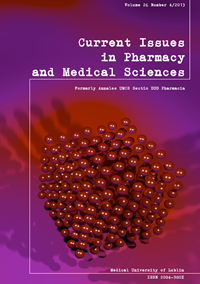Assessment of dentin reaction after Biodentine application
DOI:
https://doi.org/10.12923/j.2084-980X/26.4/a.19Keywords:
dentin, Biodentine, microspectral analysisAbstract
Recently it has been shown that very deep lesions, extending through the enamel into the dentin, can still be remineralized when brought into contact with a mineralizing agent. Biodentine is a calcium silicate based dentin substitute recommended to use in dentistry for direct and indirect pulp capping, perforations, apexification and retrograde root filling. The aim of the study was to examine the reaction between Biodentine and dentin comparing chemical composition of both of them in microspectral analysis. The human molars dentinal samples with Biodentine were analyzed by scanning electron microscopy (SEM) and electron probe microanalyser (EDS) with image observation function. Aditionally Raman microscope was used to identify Biodentine/denine interface. The results showed that Biodentine released some of its components into dentin specimens and caused the uptake of Ca and Si in the adjacent dentine. The formation of an interfacial layer at the Biodentine/dentin border was identified as a “Transition Zone”. On the basis of performed experiment it can be concluded that Biodentine is an active dental material and microanalytic methods used in the study are suitable to investigate it. The obtained outcomes can open up possibilities for a non-operative approach to deep caries cavities.
References
1. Boukpessi T. et al.: Biodentine™-RD94, a Portland cement, stimulates in vivo reactionary dentin formation, Journee Scientifique du CNEOC, Brest, June 2009.
2. Camilleri J.: Characterization and chemical activity of Portland cement and two experimental cements with potential for use in dentistry. Int. Endod. J. 41, 791, 2008.
3. Goldberg M., Pradelle-Plasse N. (2009): Chapter VI Emerging trends in (bio)material researches: VI-1-Repair or regeneration, a short review. VI-2-An example of new material: preclinical multicentric studies on a new Ca3SiO5-based dental material. Coxmoor Publishing Co., p.181-203.
4. Han L., Okiji T.: Uptake of calcium and silicon released from calcium silicate-based endodontic materials into root canal dentine. Int. Endod. J., 44, 1081, 2011.
5. Han L., Okiji T.: Bioactivity evaluation of three calcium silicate-based endodontic materials. Int. Endod. J., 46, 808, 2013.
6. Królikowska-Prasał I., Czerny K., Majewska T. (1993): Histomorfologia narządu zębowego. Lublin, Delfin.
7. Laurent P. et al.: Induction of specific cell responses to a Ca(3)SiO(5)-based posterior restorative material. Dent. Mater., 24, 1486, 2008.
8. Laurent P., Camps J., About I.: Biodentine induces TGF-β1 release from human pulp cells and early dental pulp mineralization. Int. Endod. J., 45, 439, 2012.
9. Lipski M. et al.: Porównanie szczelności preparatów MTA i Biodentine zastosowanych do wypełnienia wstecznego kanałów korzeniowych. Mag. Stomat., 6, 82, 2012.
10. Lyon A.L. et al.: Raman spectroscopy, Anal. Chem., 70, 341R, 1998.
11. Mielko E., Chałas R.: Microspectral examination of Biodentine preparation. Mag. Stomat., 7-8, 103, 2013.
12. Nowicka A. et al.: Pokrycie bezpośrednie miazgi zębów stałych z użyciem preparatu Biodentine. Doniesienie wstępne. Mag. Stomat., 4, 30, 2012.
13. R&D Department Septodont, Active Biosilicate Technology. Scientific File.
14. Świtalska I., Jaroch J., Pawlicka H.: Biodentine – nowy materiał na bazie krzemianu wapnia. Przegląd piśmiennictwa. e-Dentico, 31, 58, 2011.
15. Tsuda H., Ruben J., Arends J.: Raman spectra of human dentin mineral. Eur. J. Oral Sci. 104, 123, 1996.
Downloads
Published
Issue
Section
License
Copyright (c) 2013 Authors

This work is licensed under a Creative Commons Attribution-NonCommercial-NoDerivatives 3.0 Unported License.


